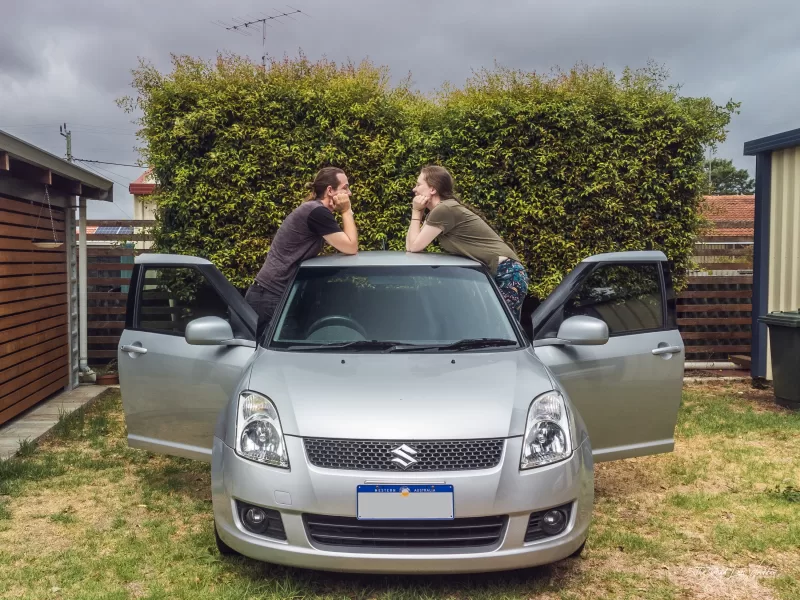We all know and love the dream of vanlife. It seems like an ideal way to live, and living in such a tiny space must have a small impact on the environment too, right? We’ve been living out our vanlife journey for over a year now and in that time have been wondering a bit more about what kind of impact our lifestyle is having on the environment. How eco-friendly is vanlife exactly?
How big is our carbon footprint and has it grown or shrunk since we took up this lifestyle?
If you care about the environment and are looking into living in a van, then this would have to be one of your top considerations. We figured our carbon footprint wouldn’t be too bad, but since having a relative laugh at our naivety, we thought we would crunch the numbers and find out!
Be sure to check out our Instagram to follow all of our vanlife adventures!
Our Emissions

Firstly, let’s start by looking at an estimate of our carbon footprint before we switched up our lives and started living on the road. To get an idea of what that would be, we’ll roughly break down our lifestyle prior to vanlife for you.
We both worked full time and drove our own cars to work. Tiff didn’t have a super long drive to get to her workplace as a radiographer, and only filled up her Suzuki Swift every second week.Nathan, on the other hand, being a carpenter and working as maintenance for houses all over Perth, drove to multiple jobs in one day. He filled up his work Ute once a week.
When we drove places on the weekend or went on road trips down to visit family in Busselton, we took Tiff’s car as its smaller and more fuel efficient. In the full year we worked before quitting, we took a return flight to Melbourne together, 4 road trips down south and Tiff flew to the UK for 3 weeks by herself. As you can see, that’s a fair amount of travel and a lot of fuel use.
Australia

Using this website, Carbon Positive Australia, we put all this in, used the average stats for water, gas and electricity consumption for the state we lived in and put in our weekly spending of about $250 on food, drinks and eating out. Household waste is also calculated, and this is somewhere we did good back home. We reduced our plastic waste where we could and were pretty good with food waste too! The numbers crunched to add up to a combined carbon footprint of 35 tonnes of CO2.
Australia’s average CO2 footprint per person is 17 tonnes, so we were only slightly above average here. Not great when you consider that according to the UN, to reach the goal of limiting globally warming to 1.5 degrees, each person needs to limit their yearly CO2 emissions to just 2 tonnes of CO2. Clearly, we needed to make a change! But did hitting the road in a diesel van make a change for the better or worse?
New Zealand

To calculate our carbon footprint for a year of vanlife, we used the first year we spent in Aotearoa, New Zealand. During this year we spent a good 4-5 months in Hamilton, so we used Hamilton City Council averages to calculate our emissions for things like water, electricity and gas. We included the fact that we have solar panels on the van into the equation as well. During this year of vanlife and working on the road, we really cut down on our food spending and on our meat consumption.
We became a lot more aware of our impact on the environment…
… with Tiff walking to work in Hamilton and us freedom camping a bit during the year. Freedom camping cuts down our water usage as we don’t shower in the van, we either swim in the ocean, lakes or rivers, have a sink bath and occasionally shower at campsites or swimming pools. Our waste is a lot less as we’ve started shopping at bulk food stores with our own containers, switched to shampoo and conditioner bars and Nathan has time to make pasta from scratch!
We used this NZ site, Future Fit, to calculate our carbon footprint in New Zealand. Including all the above and a return flight back home, it came to 7 tonnes of CO2 for one person. That’s 14 tonnes. Less than half of what we were emitting back home! This seemed a little too good to be true, to be honest, so we ran the numbers through the Aus site to see if it came up with a similar reduction in emissions.
It came to 17 tonnes of CO2. Remembering that a lot of the electricity in Aus isn’t as clean as NZ, this seems to add up. The average CO2 emissions per person in New Zealand are 7.7tonnes, so we are only slightly below average here. Still, this is a huge step in the right direction for our own personal CO2 footprint.
The Comparison
That’s quite the reduction in CO2 emissions! Did a lot of it have to do with living in a van or is it that we became more environmentally conscious during the switch the vanlife? Well, I think it’s a bit of both. Changing our lifestyle from full-time work and occasional quick travel to vanlife which is full time slow travel and part time stints at work, has made a huge impact on our time.
We no longer jet set across the world on short trips, which lets face it, is a huge part of our footprint prior to vanlife
We spend a lot more time in nature and have time to shop more consciously, too. Whilst the diesel van itself is definitely not great for the environment (as pointed out by Tiff’s uncle) it has led us to a more environmentally friendly lifestyle. Living in the van also means that we only use electricity from the grid when Tiff is working and we live in a house.
We use far less water in the van than living in a house. We shower less, we don’t have a water hungry toilet (each flush of our van toilet is less than a cup of water) and we have time to cook foods from scratch rather than from a packet. If we hadn’t switched to vanlife, this wouldn’t be the case. So is vanlife eco friendly?
So How Eco-Friendly is Vanlife?

In short, any lifestyle can be eco friendly. It really depends on the person and the effort they put in to being environmentally conscious. Our vanlife is far better for the environment than our previous way of living. However, the next van lifer could be living with a higher CO2 footprint if they aren’t taking steps to minimise their impact. It’s also incredibly hard to accurately calculate your carbon footprint.
There is carbon in almost everything we do. Fitting that all into a neat calculation that doesn’t take you a month to calculate is incredibly difficult and kind of pointless. These are all estimates of how we are living to give us an idea of what we are doing right and where we can improve. Your lifestyle creates as big or small a footprint as YOU decide. Vanlife is what you make it. If you want your vanlife to be as eco-conscious as possible, then put in the work and it will be!
Keen for more inspo? Be sure to check out:
- 10 Game Changing Vanlife Money Saving Tips
- Vanlife in New Zealand: How to Start and What it Costs
- Campervan Essentials For Your Next Home on Wheels
Want to know more about our story?





